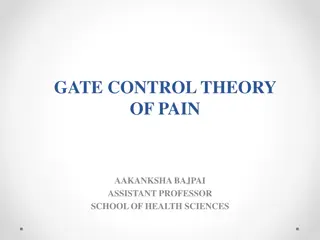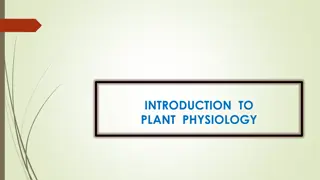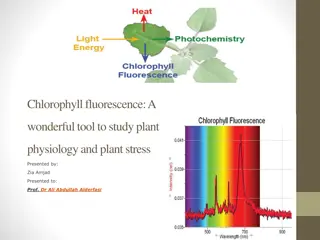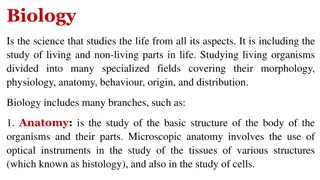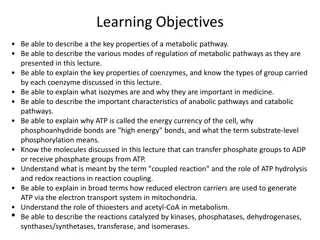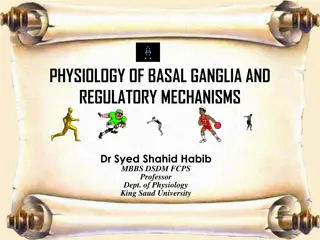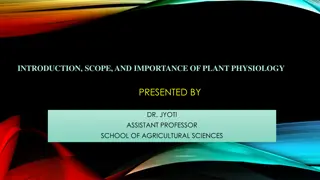Proprioception Pathways in Physiology
This information delves into the intricate pathways of proprioception, focusing on the somatotopic organization of ascending sensory pathways, types of receptors involved, dorsal column tracts like gracilus and cuneatus, spinocerebellar tracts, and the role of the cerebral cortex in perceiving proprioceptive sensations. It explains how sensory information travels through the dorsal column-medial lemniscal system and the anterolateral system to reach the brain, emphasizing the significance of large myelinated nerve fibers for rapid transmission. Various touch sensations and their specific receptors are also elucidated, shedding light on the complex process of transmitting sensory input for perception.
Download Presentation

Please find below an Image/Link to download the presentation.
The content on the website is provided AS IS for your information and personal use only. It may not be sold, licensed, or shared on other websites without obtaining consent from the author.If you encounter any issues during the download, it is possible that the publisher has removed the file from their server.
You are allowed to download the files provided on this website for personal or commercial use, subject to the condition that they are used lawfully. All files are the property of their respective owners.
The content on the website is provided AS IS for your information and personal use only. It may not be sold, licensed, or shared on other websites without obtaining consent from the author.
E N D
Presentation Transcript
Pathways of Pathways of Proprioception Proprioception Dr Abdulrahman Alhowikan Collage of medicine Physiology Dep.
To know the somatotopic organization of ascending sensory pathways To k now the types of receptors needed To know the names of tracts in dorsal column To understand the gracilus and cuneatus tracts with its functions. To know the role of spinocerebellar tracts. Role of cerebral cortex in perception of proprioceptive sensation.
All sensory information from the somatic segments of the body enters the spinal cord through the dorsal roots of the spinal nerves. then to the brain. It carried through two sensory pathways: (1) the dorsal column-medial lemniscal system or (2) the anterolateral system. !! These two systems come back together partially at the level of the thalamus.
Carries signals upward to the medulla of the brain mainly in the dorsal columns of the cord. Then, after the signals synapse and cross to the opposite side in the medulla. They continue upward through the brain stem to the thalamus by way of the medial lemniscus
It composed of large, myelinated nerve fibers that transmit signals to the brain at velocities of 30 to 110 m/sec It has a high degree of spatial orientation ( decide places and time )of the nerve fibers with respect to their origin For sensory information that must be transmitted rapidly.
1. Touch sensations requiring a high degree of localization of the stimulus 2. Touch sensations requiring transmission of fine degrees of intensity 3. Phasic (continuous) sensations, such as vibratory sensations 4. Sensations that signal movement against the skin 5. Position sensations from the joints 6. Pressure sensations related to fine degrees of judgment of pressure intensity
nerve fibers entering the dorsal columns pass uninterrupted up to the dorsal medulla, where they synapse in the dorsal column nuclei then cross to the opposite side of the brain stem and continue upward through the medial lemnisci to the thalamus. each medial lemniscus is joined by additional fibers from the sensory nuclei
In the thalamus, the medial lemniscal fibers terminate in the thalamic sensory relay area, called the ventrobasal complex. From the ventrobasal complex,third-order nerve fibers project.
The various areas of the cortex. Is a map of the human cerebral cortex, showing that it is divided into about 50 distinct areas called brodmann's areas based on histological structural differences Figure 47-5 Structurally distinct areas, called Brodmann's areas, of the human cerebral cortex. Note specifically areas 1, 2, and 3, which constitute primary somatosensory area I, and areas 5 and 7, which constitute the somatosensory association area.
Somatosensory area I is so much more extensive and so much more important than somatosensory area II Somatosensory area I has a high degree of localization of the different parts of the body Two somatosensory cortical areas, somatosensory areas I and II.
Some areas of the body are represented by large areas in the somatic cortex-the lips the greatest of all, followed by the face and thumb-whereas the trunk and lower part of the body are represented by relatively small areas. different areas of the body in somatosensory area I of the cortex. (From Penfield W, 1968.)
Incoming sensory signal stimulate neuronal layer IV first; then spreads toward surface and deeper layers of cortex. Layers i and ii receive diffuse, nonspecific input signals from lower brain centers Layers II and III send axons to related portions of the cerebral cortex on the opposite side of the brain. The neurons in layers v and vi send axons to the deeper parts of the nervous system. Layer V to more distant areas, layer VI, especially large numbers of axons extend to the thalamus.
gracilis and cuneate tracts offer the same functions but can be differentiated by the vertebral level Cuneatus carries information from vertebral level T6 and up. transmits information from the arms fine touch, fine pressure, vibration, and proprioception information Gracilus carries information from vertebral levels below T6 provides proprioception of the lower limbs and trunk to the brain stem.
Bilateral removal of somatosensory area I causes loss of the following types of sensory judgment: The person is unable to localize discretely the different sensations in the different parts of the body. Unable to judge degrees of pressure against the body. Unable to judge the weights of objects. Unable to judge shapes or forms of objects. This is called astereognosis. Unable to judge feel of materials by movement of the fingers over the surface to be judged.
Play important roles in interpret deeper meanings of the sensory information in the somatosensory areas. It combines information arriving from multiple points in the primary somatosensory area to interpret its meaning. areas 5 and 7, which constitute the somatosensory association area.
It receives signals from (1) somatosensory area I, (2) the ventrobasal nuclei of the thalamus, (3) other areas of the thalamus, (4) the visual cortex, and (5) the auditory cortex areas 5 and 7, which constitute the somatosensory association area.
Entering the spinal cord from the dorsal spinal nerve roots, synapse in the dorsal horns of the spinal gray matter Then cross to the opposite side of the cord and ascend through the anterior and lateral white columns of the cord. They terminate at all levels of the lower brain stem and in the thalamus
Composed of smaller myelinated fibers that transmit signals at velocities ranging from a few meters per second up to 40 m/sec. It has much less spatial orientation ( decide places and time ). Does not need to be transmitted rapidly or with great spatial fidelity ( accuracy)
Pain Thermal sensations, warmth and cold sensations Crude touch (gross) and pressure sensations capable only of crude localizing ability on the surface of the body Tickle and itch sensations Sexual sensations
Anterolateral fibers cross immediately in the anterior commissure of the cord to the opposite anterior and lateral white columns, where they turn upward toward the brain by way of the anterior spinothalamic and lateral spinothalamic tracts Anterior and lateral divisions of the anterolateral sensory pathway.
Same principles of transmission in anterolateral pathway as in the dorsal column-medial lemniscal system, except : (1) the velocities of transmission are only one- third to one-half those in the dorsal column- medial lemniscal system, 8 and 40 m/sec; (2) the degree of spatial localization of signals is poor (3) the gradations of intensities are also far less accurate, (4) the ability to transmit signal rapidly is poor.
Reference book Guyton & Hall: Textbook of Medical Physiology 12E Thank you Thank you






